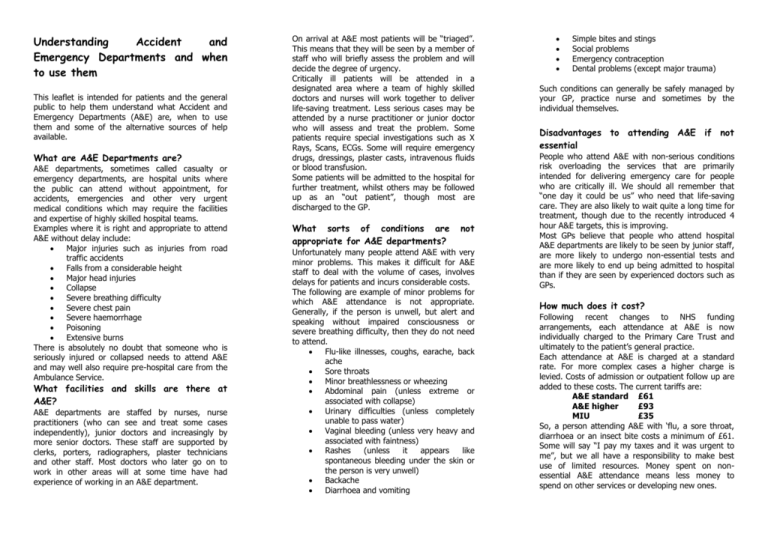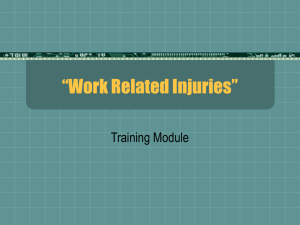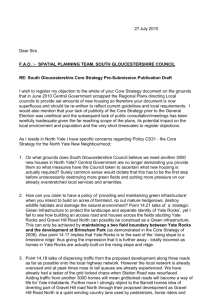Understanding Accident and Emergency Departments and when to
advertisement

Understanding Accident and Emergency Departments and when to use them This leaflet is intended for patients and the general public to help them understand what Accident and Emergency Departments (A&E) are, when to use them and some of the alternative sources of help available. What are A&E Departments are? A&E departments, sometimes called casualty or emergency departments, are hospital units where the public can attend without appointment, for accidents, emergencies and other very urgent medical conditions which may require the facilities and expertise of highly skilled hospital teams. Examples where it is right and appropriate to attend A&E without delay include: Major injuries such as injuries from road traffic accidents Falls from a considerable height Major head injuries Collapse Severe breathing difficulty Severe chest pain Severe haemorrhage Poisoning Extensive burns There is absolutely no doubt that someone who is seriously injured or collapsed needs to attend A&E and may well also require pre-hospital care from the Ambulance Service. What facilities and skills are there at A&E? A&E departments are staffed by nurses, nurse practitioners (who can see and treat some cases independently), junior doctors and increasingly by more senior doctors. These staff are supported by clerks, porters, radiographers, plaster technicians and other staff. Most doctors who later go on to work in other areas will at some time have had experience of working in an A&E department. On arrival at A&E most patients will be “triaged”. This means that they will be seen by a member of staff who will briefly assess the problem and will decide the degree of urgency. Critically ill patients will be attended in a designated area where a team of highly skilled doctors and nurses will work together to deliver life-saving treatment. Less serious cases may be attended by a nurse practitioner or junior doctor who will assess and treat the problem. Some patients require special investigations such as X Rays, Scans, ECGs. Some will require emergency drugs, dressings, plaster casts, intravenous fluids or blood transfusion. Some patients will be admitted to the hospital for further treatment, whilst others may be followed up as an “out patient”, though most are discharged to the GP. What sorts of conditions are appropriate for A&E departments? not Unfortunately many people attend A&E with very minor problems. This makes it difficult for A&E staff to deal with the volume of cases, involves delays for patients and incurs considerable costs. The following are example of minor problems for which A&E attendance is not appropriate. Generally, if the person is unwell, but alert and speaking without impaired consciousness or severe breathing difficulty, then they do not need to attend. Flu-like illnesses, coughs, earache, back ache Sore throats Minor breathlessness or wheezing Abdominal pain (unless extreme or associated with collapse) Urinary difficulties (unless completely unable to pass water) Vaginal bleeding (unless very heavy and associated with faintness) Rashes (unless it appears like spontaneous bleeding under the skin or the person is very unwell) Backache Diarrhoea and vomiting Simple bites and stings Social problems Emergency contraception Dental problems (except major trauma) Such conditions can generally be safely managed by your GP, practice nurse and sometimes by the individual themselves. Disadvantages to attending A&E if not essential People who attend A&E with non-serious conditions risk overloading the services that are primarily intended for delivering emergency care for people who are critically ill. We should all remember that “one day it could be us” who need that life-saving care. They are also likely to wait quite a long time for treatment, though due to the recently introduced 4 hour A&E targets, this is improving. Most GPs believe that people who attend hospital A&E departments are likely to be seen by junior staff, are more likely to undergo non-essential tests and are more likely to end up being admitted to hospital than if they are seen by experienced doctors such as GPs. How much does it cost? Following recent changes to NHS funding arrangements, each attendance at A&E is now individually charged to the Primary Care Trust and ultimately to the patient’s general practice. Each attendance at A&E is charged at a standard rate. For more complex cases a higher charge is levied. Costs of admission or outpatient follow up are added to these costs. The current tariffs are: A&E standard £61 A&E higher £93 MIU £35 So, a person attending A&E with ‘flu, a sore throat, diarrhoea or an insect bite costs a minimum of £61. Some will say “I pay my taxes and it was urgent to me”, but we all have a responsibility to make best use of limited resources. Money spent on nonessential A&E attendance means less money to spend on other services or developing new ones. What alternatives are there to attending A&E? General Practices provide comprehensive services between 8am and 6.30pm Monday to Friday. All practices can provide same day appointments for urgent problems. Some practices have nurse practitioners or practice nurses who can see and advise patients themselves. Most GPs can arrange to telephone a patient to offer advice if requested to do so. When practices are closed during the evenings, weekends and bank holidays, there is an Out of Hours Service for urgent medical problems which cannot wait until the person’s own practice is open. If you do not have the number of the OOH service, just telephone your usual surgery number and you will either be transferred or will hear a message giving you the number to ring. The Orchard Medical Centre – Kingswood has appointments available even if you are not registered with them. Contact 0117 9805100 and you can arrange to be seen by a doctor or nurse. Orchard Medical Centre, Macdonald Walk, Bristol BS15 8NJ (Nr Somerfield). Open 7 days a week from 8.00am to 8.00pm. There are additional NHS Walk in Centres in Knowle and Central Bristol, which can treat minor illnesses. Central Bristol: 33 Board Street, Bristol BS1 2EZ. Open Monday to Saturday from 8.00am to 8.00pm; Sundays and Bank Holidays open from 10am to 6pm. Knowle: West Health Park, Downton road, Bristol BS4 1WH open 7 days a week 9am – 9pm Minor Injuries Unit at Yate West Gate Centre Yate Minor Injury Unit will be open Monday – Friday 8am – 7:30 pm, Saturday and Sunday 10am – 2pm from 22nd June 2010. It is located at West Walk, Shopping Centre, Yate BS37 4AX. Yate Minor Injuries Unit Southmead Hospital Southmead Hospital has a designated Minor Injuries Unit (MIU) open 9am until 9pm seven days a week. The Minor Injuries Unit is located at the Monk Park entrance, Bristol BS10 5NB. Both Minor Injury Units are staffed by highly trained nurses to deal with minor injuries such as wounds, sprains, minor fractures and minor head injuries where the patient does not need the facilities of a major A&E department and parking is available. Most pharmacies can advise on minor illness and can provide medication to help you manage your condition yourself. Pharmacies can also provide emergency contraception and some pharmacies are open extended hours. NHS Direct (0845 4647) or www.nhsdirect.nhs.uk can provide information on what to do if you are not sure, as well as information about local services such as pharmacy opening times and emergency dental care. Understanding Accident and Emergency departments and when to use them.









